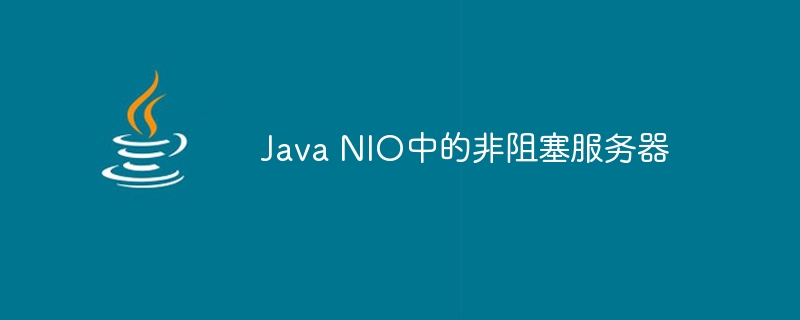Java NIO中的非阻塞服务器

Non-blocking Server
Java NIO (New Input/Output) is a very powerful networking and file-handling application that functions as an alternative to Java's standard IO API. Due to the addition of more sophisticated features since JDK 4's introduction, it has quickly emerged as the preferred I/O system among numerous engineers.
Java NIO提供的对文件处理和文件系统功能的改进支持是其区别于其他特性之一。由于NIO文件类具有如此强大的功能,因此在文件处理中被广泛使用。
如果你仔细观察,你会注意到java.nio包指定了NIO API中使用的缓冲区类。最好的一点是,它是为了让Java程序员能够在不编写本地代码的情况下实现快速I/O而创建的。
阻塞与非阻塞I/O
由于其使用了非阻塞I/O,非阻塞服务器可以通过同一进程或线程同时处理多个请求。将阻塞进程视为售票处的队列,每个顾客必须等待前面的人被服务完才能继续。
In contrast, a non-blocking process is like a waiter at a restaurant who tries to serve all customers simultaneously by rotating through them and taking care of their orders.
阻塞服务器以同步方式工作,完成每个请求后再转到下一个。这可能导致客户端等待时间较长,并且需要多个线程来处理每个请求,使其对CPU要求较高。另一方面,非阻塞服务器采用异步方法,允许一个线程在同一时间处理多个查询,对每个请求的完成做出反应。
Java NIO的特点
Java NIO 有一些独特的特点,使其与其他 IO 系统区别开来。以下是 Java NIO 的主要特点:
Asynchronous and Non-Blocking IO − This feature allows for threads to perform other tasks while data is being read into a buffer. Instead of waiting for data to be fully loaded before processing begins, threads can continue their work while the data is being read.
缓冲区导向的方法 − Java NIO将数据存储在缓冲区中,这样可以快速访问和处理。当需要数据时,它会从缓冲区中检索和处理。
算法
Step 1 − To begin with, we must import the necessary classes using the import statement.
Step 2 − Next, we need to create a public class named "WriteExample2."
Step 3 − Inside this class, we must define a public static void main function that accepts String-type variable arguments.
Step 4 − Now, create a temporary file with the ".txt" extension by using the Files.createTempFile() method. To write, we can use the Files.write() method along with an iterable object holding the strings "Hello" and "world."
Step 5 − To read every byte from the file defined by the Path object returned by the Files' createTempFile() function, we can use the Files.readAllBytes() function. After that, we need to convert them to a String using the new String() constructor.
Step 6 − Lastly, print the String to the console using the System.out.println() method.
Example 1
This Java code creates a temporary text file and writes "Hello" and "world" to it. It then reads the file and prints its contents. The code uses the Files class from the Java NIO package to handle file operations.
package com.tutorialspoint.example.files;
import java.io.IOException;
import java.nio.file.Files;
import java.nio.file.Path;
import java.util.Arrays;
public class WriteExample2 {
public static void main(String... args) throws IOException {
Path path = Files.createTempFile("test-file", ".txt");
Iterable<String> iterable = Arrays.asList("Hello", "world");
Files.write(path, iterable);
byte[] bytes = Files.readAllBytes(path);
System.out.println(new String(bytes));
}
}
输出
Hello world
Components of Java NIO
Java NIO is built on three fundamental components: Buffers, Channels, and Selectors. Here's a brief overview of each −
缓冲区− 缓冲区是一块用于临时存储数据的内存块,用于在数据从一个位置传输到另一个位置时使用。在Java NIO中,缓冲区用于方便地读取和写入数据。
通道 - 在Java NIO中,通道代表与可以执行IO操作的对象(如文件和套接字)的连接。通道负责在缓冲区和它们所代表的对象之间传输数据。
Selectors − A selector is a Java NIO component used to monitor one or more channels for events, such as readiness to perform an I/O operation. When a channel is ready, the selector can wake up and allow the appropriate thread to handle the operation.
Non-Blocking Server Composition
Non-blocking servers are composed of a non-blocking IO pipeline, which is a chain of components that process both read and write IO operations in a non-blocking fashion. Here's a breakdown of how this pipeline works −
A selector is used by each component in the pipeline to determine whether a channel has data to read.
When there is data, the component reads it and provides output based on it. After that, the output is written back to the channel.
基于组件,非阻塞IO管道可以读取和写入数据,以及执行这两种操作。
该组件通过选择器从通道中读取数据。Java NIO管理非阻塞IO操作,而选择器和可选择通道的选择键定义了多路复用的IO操作。
Non-blocking IO pipelines divide data into logically ordered or combined messages alongside non-blocking data processing. This is comparable to using Java's StreamTokenizer class to tokenize a stream of data before processing it.
Non-blocking models employ Java NIO selectors to check and give only those SelectableChannel instances that have data to read, as opposed to blocking IO pipelines, which use an interface similar to InputStream and only allow one byte to be read at a time.
Comparison of Blocking and Non-Blocking Models for Server Read/Write Operations
在服务器架构的世界中,选择使用阻塞或非阻塞模型来进行读写操作,可以极大地影响服务器的效率和可扩展性。
非阻塞模型与阻塞模型相反,它允许一个进程通过交错非阻塞I/O调用来处理多个并发请求。
To illustrate the difference between these models, let's consider a hypothetical server that receives two requests. In a blocking model, the process must wait for request A to be fully processed before moving on to request B. In contrast, a non-blocking model can handle both requests simultaneously by interleaving the processing of requests A and B.
Java NIO使得单个线程能够控制多个通道,支持非阻塞I/O。
The channels that link a buffer and an object at the other end make asynchronous data transfer possible. Two classes, SocketChannel and ServerSocketChannel, implement the Java NIO channel and make it possible to receive and write data over TCP connections.
Server architects can create systems that are effective, scalable, and can manage numerous simultaneous requests by selecting the proper I/O model.
结论
Java NIO provides a powerful networking and file-handling application with improved support for file handling and file system features. Its asynchronous and non-blocking I/O, buffer-oriented approach, and three fundamental components of buffers, channels, and selectors make it a unique I/O system.
Java NIO的非阻塞服务器模型能够通过使用非阻塞I/O管道同时处理多个请求。与阻塞I/O管道不同,非阻塞模型只检查和提供那些实际上有数据可读的SelectableChannel实例,使其成为一个更快、更高效的系统。
以上是Java NIO中的非阻塞服务器的详细内容。更多信息请关注PHP中文网其他相关文章!

热AI工具

Undresser.AI Undress
人工智能驱动的应用程序,用于创建逼真的裸体照片

AI Clothes Remover
用于从照片中去除衣服的在线人工智能工具。

Undress AI Tool
免费脱衣服图片

Clothoff.io
AI脱衣机

Video Face Swap
使用我们完全免费的人工智能换脸工具轻松在任何视频中换脸!

热门文章

热工具

记事本++7.3.1
好用且免费的代码编辑器

SublimeText3汉化版
中文版,非常好用

禅工作室 13.0.1
功能强大的PHP集成开发环境

Dreamweaver CS6
视觉化网页开发工具

SublimeText3 Mac版
神级代码编辑软件(SublimeText3)
 公司安全软件导致应用无法运行?如何排查和解决?
Apr 19, 2025 pm 04:51 PM
公司安全软件导致应用无法运行?如何排查和解决?
Apr 19, 2025 pm 04:51 PM
公司安全软件导致部分应用无法正常运行的排查与解决方法许多公司为了保障内部网络安全,会部署安全软件。...
 如何使用MapStruct简化系统对接中的字段映射问题?
Apr 19, 2025 pm 06:21 PM
如何使用MapStruct简化系统对接中的字段映射问题?
Apr 19, 2025 pm 06:21 PM
系统对接中的字段映射处理在进行系统对接时,常常会遇到一个棘手的问题:如何将A系统的接口字段有效地映�...
 如何优雅地获取实体类变量名构建数据库查询条件?
Apr 19, 2025 pm 11:42 PM
如何优雅地获取实体类变量名构建数据库查询条件?
Apr 19, 2025 pm 11:42 PM
在使用MyBatis-Plus或其他ORM框架进行数据库操作时,经常需要根据实体类的属性名构造查询条件。如果每次都手动...
 IntelliJ IDEA是如何在不输出日志的情况下识别Spring Boot项目的端口号的?
Apr 19, 2025 pm 11:45 PM
IntelliJ IDEA是如何在不输出日志的情况下识别Spring Boot项目的端口号的?
Apr 19, 2025 pm 11:45 PM
在使用IntelliJIDEAUltimate版本启动Spring...
 如何将姓名转换为数字以实现排序并保持群组中的一致性?
Apr 19, 2025 pm 11:30 PM
如何将姓名转换为数字以实现排序并保持群组中的一致性?
Apr 19, 2025 pm 11:30 PM
将姓名转换为数字以实现排序的解决方案在许多应用场景中,用户可能需要在群组中进行排序,尤其是在一个用...
 Java对象如何安全地转换为数组?
Apr 19, 2025 pm 11:33 PM
Java对象如何安全地转换为数组?
Apr 19, 2025 pm 11:33 PM
Java对象与数组的转换:深入探讨强制类型转换的风险与正确方法很多Java初学者会遇到将一个对象转换成数组的�...
 使用TKMyBatis进行数据库查询时,如何优雅地获取实体类变量名构建查询条件?
Apr 19, 2025 pm 09:51 PM
使用TKMyBatis进行数据库查询时,如何优雅地获取实体类变量名构建查询条件?
Apr 19, 2025 pm 09:51 PM
在使用TKMyBatis进行数据库查询时,如何优雅地获取实体类变量名以构建查询条件,是一个常见的难题。本文将针...
 为什么Spring项目启动时会因为循环依赖导致随机性问题?
Apr 19, 2025 pm 11:21 PM
为什么Spring项目启动时会因为循环依赖导致随机性问题?
Apr 19, 2025 pm 11:21 PM
理解Spring项目启动中循环依赖的随机性在进行Spring项目开发时,可能会遇到项目启动时由于循环依赖导致的随机...






